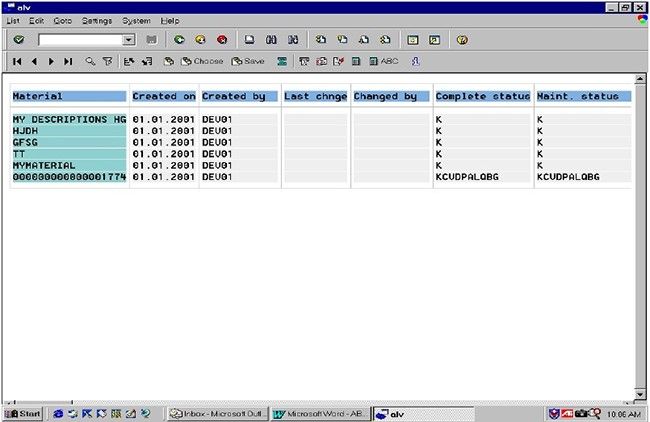Using ALV, we can have three types of reports:
There are some function modules which will enable to produce the above reports without much effort.
All the definitions of internal tables, structures and constants are declared in a type-poolcalled SLIS.
- Simple Report
- Block Report
- Hierarchical Sequential Report
SIMPLE REPORT
ReportThe important function modules are:
- Reuse_alv_list_display
- Reuse_alv_fieldcatalog_merge
- Reuse_alv_events_get
- Reuse_alv_commentary_write
- Reuse_alv_grid_display
A. REUSE_ALV_LIST_DISPLAY : This is the function module which prints the data.
The important parameters are:
1. Export:
a. I_callback_program : report id
b. I_callback_pf_status_set : routine where a user can set his own pf status or change the functionality of the existing pf status.
c. I_callback_user_command : routine where the function codes are handled.
d. I_structure name : name of the dictionary table
e. Is_Layout : structure to set the layout of the report
f. It_fieldcat : internal table with the list of all fields and their attributes which are to be printed (this table can be populated automatically by the function module REUSE_ALV_FIELDCATALOG_MERGE)
g. It_events : internal table with a list of all possible events of ALV and their corresponding routine names.
2. Tables:
a. t_outtab: internal table with the data to be output
B. REUSE_ALV_FIELDCATALOG_MERGE : This function module is used to populate a fieldcatalog which is essential to display the data in ALV. If the output data is from a single dictionary table and all the columns are selected, then we need not exclusively create the field catalog. Its enough to mention the table name as a parameter(I_structure_name) in the REUSE_ALV_LIST_DISPLAY. But in other cases we need to create it.
The important parameters are:
1. Export:
a. I_program_name : report id
b. I_internal_tabname : the internal output table
c. I_inclname : include or the report name where all the dynamicforms are handled.
2. Changing
ct_fieldcat : an internal table with the type SLIS_T_FIELDCAT_ALVwhich is declared in the type pool SLIS.
C . REUSE_ALV_EVENTS_GET : Returns table of possible events for a a list type
1. Import:
Et_Events : The event table is returned with all possibleCALLBACK events for the specified list type(column ‘NAME’). For events to be processed bythe Callback, their ‘FORM’ field must be filled. Ifthe field is initialized, the event is ignored. Theentry can be read from the event table, the field‘FORM’ filled and the entry modified usingconstants from the type pool SLIS.
2. Export:
I_list_type:
0 = simple list
1 = hierarchical-sequential list
2 = simple block list
3 = hierarchical-sequential block list
D. REUSE_ALV_COMMENTARY_WRITE : This is used in the Top-of-page event to print the headings and other comments for the list.
1.It_list_commentary : Internal table with the headings of the type slis_t_listheader.
This internal table has three fields:
Typ : ‘H’ -header, ‘S’ -selection, ‘A’ -action
Key : only when typ is ‘S’.
Info : the text to be printed
E. REUSE_ALV_GRID_DISPLAY : A new function in 4.6 version, to display the results in grid rather than as a list.
Parameters : same as reuse_alv_list_display
The example of a simple list is as follows:

HIERARCHICAL REPORTS
Hierarchical sequential list output.
The function module is
A. REUSE_ALV_HIERSEQ_LIST_DISPLAY
1. Export:
a. I_CALLBACK_PROGRAM
b. I_CALLBACK_PF_STATUS_SET
c. I_CALLBACK_USER_COMMAND
d. IS_LAYOUT
e. IT_FIELDCAT
f. IT_EVENTS
g. I_TABNAME_HEADER : Name of the internal table in the program containing the output data of the highest hierarchy level.
h. I_TABNAME_ITEM : Name of the internal table in the program containing the output data of the lowest hierarchy level.
i. IS_KEYINFO : This structure contains the header and item table field names which link the two tables (shared key).
2. Tables
a. T_OUTTAB_HEADER : Header table with data to be output
b. T_OUTTAB_ITEM : Name of the internal table in the program containing the output data of the lowest hierarchy level.

BLOCK REPORT
This is used to display multiple lists continuously.
The important functions used in this report are:
A. REUSE_ALV_BLOCK_LIST_INIT
B. REUSE_ALV_BLOCK_LIST_APPEND
D. REUSE_ALV_BLOCK_HS_LIST_APPENDC
C. REUSE_ALV_BLOCK_LIST_DISPLAY
A. REUSE_ALV_BLOCK_LIST_INIT
Parameters:
a. I_CALLBACK_PROGRAM
b. I_CALLBACK_PF_STATUS_SET
c. I_CALLBACK_USER_COMMAND
COMMANDThis function module is used to set the default GUI status etc.
B. REUSE_ALV_BLOCK_LIST_APPEND
Export :
a. IS_LAYOUT : layout settings for block
b. IT_FIELDCAT : field catalog
c. I_TABNAME : Internal table name of the output data
d. IT_EVENTS: internal table name with all possible events
Tables :
a. T_OUTTAB : internal table with output data.
This function module adds the data to the block.
REUSE_ALV_LIST_HS_APPEND : -
Is used to append the Hierarchical Sequential blocks.
C. REUSE_ALV_BLOCK_LIST_DISPLAY
DISPLAYParameters : All the parameters are optional.
This function module display the list with data appended by the above function.

Here the functions REUSE_ALV_FIELDCATALOG_MERGE, REUSE_ALV_EVENTS_GET, REUSE_ALV_COMMENTARY_WRITE can be used.
INTERNAL TABLES IN SLIS
Slis_t_fieldcat_alv : This internal table contains the field attributes. This internal table can be populated automatically by using ‘REUSE_ALV_FIELDCATALOG_MERGE’.
Important Attributes:
a. col_pos : position of the column
b. fieldname : internal fieldname
c. tabname : internal table name
d. ref_fieldname : fieldname (dictionary)
e. ref_tabname : table (dictionary)
f. key(1) : column with key-color
g. icon(1) : icon
h. hotspot(1) : hotspot
i. Symbol(1) : symbol
j. Checkbox(1) : checkbox
k. just(1) : (R)ight (L)eft (C)ent
l. do_sum(1) : sum up
m. no_out(1) : (O)blig. (X)no out
n. outputlen : output length
o. seltext-l : long key word
p. seltext_m : middle key word
q. seltext_s : hort key word
r. reptext_ddic : heading(ddic)
s. ddictxt(1) : (S)hort (M)iddle (L)ong
t. datatype : datatype
2. SLIS_T_EVENT : Internal table for storing all the possible events of the ALV. This can be populated by the function module Reuse_alv_events_get.
The columns are :
• name : name of the event
• form : name of the routine
SYNTAXES FOR THE ROUTINES
• I_CALLBACK_PF_STATUS_SET
Syntax :
FORM set_pf_status USING rt_extab TYPE slis_t_extab
The table RT_EXTAB contains the function codes which are hidden in the standard interface.
• I_CALLBACK_USER_COMMAND
Syntax :
FORM user_command USING r_ucomm LIKE sy-ucommrs_selfield TYPE slis_selfield.
The parameter r_ucomm contains the function code.
The structure rs_selfield has the details about the current cursor position.